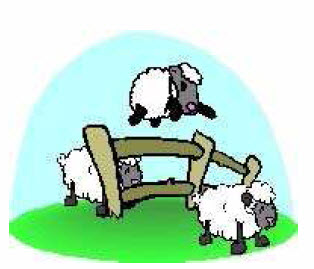HDU--2952 -- Counting Sheep [广搜]
来源:互联网 发布:c语言 项目开发实例 编辑:程序博客网 时间:2024/04/28 06:55
Counting Sheep
Time Limit: 2000/1000 MS (Java/Others) Memory Limit: 32768/32768 K (Java/Others)
Total Submission(s): 1706 Accepted Submission(s): 1104
Problem Description
A while ago I had trouble sleeping. I used to lie awake, staring at the ceiling, for hours and hours. Then one day my grandmother suggested I tried counting sheep after I'd gone to bed. As always when my grandmother suggests things, I decided to try it out. The only problem was, there were no sheep around to be counted when I went to bed.

Creative as I am, that wasn't going to stop me. I sat down and wrote a computer program that made a grid of characters, where # represents a sheep, while . is grass (or whatever you like, just not sheep). To make the counting a little more interesting, I also decided I wanted to count flocks of sheep instead of single sheep. Two sheep are in the same flock if they share a common side (up, down, right or left). Also, if sheep A is in the same flock as sheep B, and sheep B is in the same flock as sheep C, then sheeps A and C are in the same flock.
Now, I've got a new problem. Though counting these sheep actually helps me fall asleep, I find that it is extremely boring. To solve this, I've decided I need another computer program that does the counting for me. Then I'll be able to just start both these programs before I go to bed, and I'll sleep tight until the morning without any disturbances. I need you to write this program for me.

Creative as I am, that wasn't going to stop me. I sat down and wrote a computer program that made a grid of characters, where # represents a sheep, while . is grass (or whatever you like, just not sheep). To make the counting a little more interesting, I also decided I wanted to count flocks of sheep instead of single sheep. Two sheep are in the same flock if they share a common side (up, down, right or left). Also, if sheep A is in the same flock as sheep B, and sheep B is in the same flock as sheep C, then sheeps A and C are in the same flock.
Now, I've got a new problem. Though counting these sheep actually helps me fall asleep, I find that it is extremely boring. To solve this, I've decided I need another computer program that does the counting for me. Then I'll be able to just start both these programs before I go to bed, and I'll sleep tight until the morning without any disturbances. I need you to write this program for me.
Input
The first line of input contains a single number T, the number of test cases to follow.
Each test case begins with a line containing two numbers, H and W, the height and width of the sheep grid. Then follows H lines, each containing W characters (either # or .), describing that part of the grid.
Each test case begins with a line containing two numbers, H and W, the height and width of the sheep grid. Then follows H lines, each containing W characters (either # or .), describing that part of the grid.
Output
For each test case, output a line containing a single number, the amount of sheep flock son that grid according to the rules stated in the problem description.
Notes and Constraints
0 < T <= 100
0 < H,W <= 100
Notes and Constraints
0 < T <= 100
0 < H,W <= 100
Sample Input
24 4#.#..#.##.##.#.#3 5###.#..#..#.###
Sample Output
63
Code:
人家都用深搜, 为了练广搜, 哼哼!
可是万恶的Memory Limit Exceeded ! 是Memory ! MLE! KILL IT !
找到#号的地方把这一块的#号都标志, 原理跟深搜一样一样的~
#include<stdio.h>#include<queue>#include<string.h>#include<iostream>using namespace std;typedef struct point{ int x,y;}point;char sign[100][100];int n,m;int dir[4][2] = {-1,0,0,1,1,0,0,-1};void bfs(int a,int b){ queue<point>q; point p,head; p.x = a; p.y = b; q.push(p); int i; sign[a][b] = 1; while(!q.empty()){ head = q.front(); q.pop(); for(i=0;i<4;i++)//四个方向 { point next; next.x = head.x + dir[i][0]; next.y = head.y + dir[i][1]; if(next.x>=0 && next.x<n && next.y>=0 && next.y<m && !sign[next.x][next.y]){ q.push(next); sign[next.x][next.y] =1;//就是这里!!!改变标志位不能在出队的时候,否则一判断重复就MLE了啊,真是传奇! } } }}int main(){ int t,i,j,count; char str[105]; scanf("%d",&t); while(t--) { char str[105]; scanf("%d%d",&n,&m); for(i=0;i<n;i++) { scanf("%s",str); for(j=0;j<m;j++) { if(str[j]=='#') sign[i][j] = 0; else sign[i][j] = 1; } } count = 0; for(i=0;i<n;i++) { for(j=0;j<m;j++) { if(sign[i][j]==0) { bfs(i,j); count ++; } } } printf("%d\n",count); } return 0;}
- HDU--2952 -- Counting Sheep [广搜]
- HDU 2952 Counting Sheep
- hdu 2952 Counting Sheep
- hdu-2952-Counting Sheep
- hdu 2952 Counting Sheep
- hdu 2952Counting Sheep
- HDU 2952 Counting Sheep
- hdu 2952 Counting Sheep
- HDU 2952 Counting Sheep
- hdu 2952 Counting Sheep
- hdu 2952 Counting Sheep
- HDU 2952 Counting Sheep
- hdu 2952 Counting Sheep
- hdu 2952 Counting Sheep
- hdu 2952 Counting Sheep
- hdu 2952 Counting Sheep
- HDU 2952 Counting Sheep
- HDU-2952-Counting Sheep
- nyoj-106-背包问题
- 多校第八场 Hdu 4681 String
- erlang 排序算法
- The Unquiet Grave——4、The Experiment
- 用Set类判断Map里key是否存在的办法
- HDU--2952 -- Counting Sheep [广搜]
- 学生信息管理系统(一)
- 如果这点困难都克服不了,我们什么也就不必想不必做了
- 日积月累--小技巧之二
- iOS SDK:那些关于iOS调试的技巧
- SQL Server中语句的自动参数化
- 编程之美 求数组中的最长递增子序列
- Hadoop安装记录及测试
- 排序算法--选择排序


